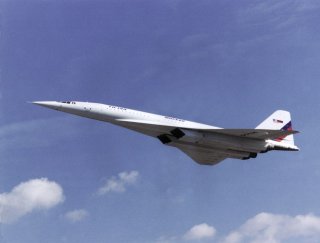Russia Tried to Build Their Own Concorde. Oh What a Mess.
Although the venerable Tupolev design bureau beat the Concorde for first supersonic jet airliner flight by a few months, it was an unmitigated disaster. Here’s why.
The Soviet-built Tu-144 actually flew before its supersonic rival Concorde, though it had a number of flaws inherent to the design that severely limited its usefulness.
Part of the problem with the Tu-144 was its weight. Not only was it heavier than the Concorde—by around 20 tons, or 40,000 pounds—it was longer too, by about 12 feet. The Tu-144’s extra weight stemmed from the extra wheels it had to carry under its wings. Unlike the French-Anglo Concorde, the Soviet Tu-144’ landing gear had a whopping 12 wheels. The Soviet-built plane used synthetic rubber for its tires, which was structurally weaker and more likely to fail than natural rubber. A quick fix—more wheels. More weight, meant more wheels, which meant more weight again.
Still, the Tu-144’s engines could compensate for the extra pounds. Each of the Tu-144’s engines produced 6,000 more pounds of thrust than those of Concorde. But they were less refined. At one point the Tupolev design bureau approached the Concorde team in order to try and negotiate an engine-management computer system for use with their Tu-144. They were rebuffed, as it was feared the technology could be used to improve Soviet bombers as well as jet airliners. The Tu-144’s performance suffered accordingly.
Overall, the Tu-144 was less refined than the Concorde. In order to slow down when landing, the Tu-144 had a brake parachute group at the tail instead of thrust reversers. Another less-refined aspect of the jet airliner was the noise generated by its enormously powerful engines for those in the cabin. Noise inside the cabin was apparently so immense that passengers were reduced to passing handwritten notes to communicate.
Postscript
Part of the Tu-144’s myriad problems are attributable to the very high level of aerospace engineering that needed to go into a viable supersonic jet airliner design. One estimate said that the Tupolev design was 10 to 15 years ahead of what the Soviet aerospace industry was capable of at that time. Obvious parallels have been made between the Concorde and the Tu-144, which hint at the danger of trying to copy a design that isn’t fully understood. The Soviet Union had a long history of aerospace espionage, which may have contributed to the Tu-144’s lack of commercial success.
The Tu-144 reportedly flew a paltry 102 flights, only 55 of which actually carried any passengers. Compared to its arch-rival Concorde, the Tu-144 was a fiasco, draining precious time and rubles from other projects. The French-Anglo venture on the other hand served just under 30 years. Though it too could not be considered a commercial success, the problems Concorde experienced were due to regulations and market forces, rather than shortcoming inherent to the airframe itself. Though unsuccessful, the Tu-144 was nevertheless impressive as the world’s largest supersonic commercial airliner.
Caleb Larson holds a Master of Public Policy degree from the Willy Brandt School of Public Policy. He lives in Berlin and writes on U.S. and Russian foreign and defense policy, German politics, and culture.
Image: Wikimedia

